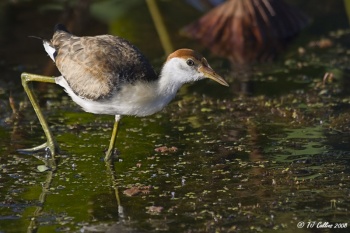- Irediparra gallinacea
Identification
21-24 cm (8¼-9½ in) female smaller than male
- Black crown and hindneck
- Red wattle covers the forehead and forecrown
- White face and throat
- Black band on lower breast
- White belly
- Black underwing
- Brown mantle, back and upperwing-coverts
- Black rump and tail
- Long legs
Distribution
Southeast Asia: Indochina, Malaysia, Philippines, Borneo, Indonesia, Greater Sundas, Sulawesi, Lesser Sundas, West Timor, Moluccas, Tanimbar Islands and Papuan Islands
Australasia: New Guinea, Australia: New South Wales, Northern Territory, Queensland, Western Australia and Melanesia.
Taxonomy
Subspecies
There are 3 subspecies1:
- I. g. gallinacea:
- Southern Borneo, Sulawesi, Mindanao, Moluccas and Lesser Sundas
- I. g. novaeguinae:
- Northern and central New Guinea, Misool Island and Aru Islands
- I. g. novaehollandiae:
- Southern New Guinea, D'Entrecasteaux Archaepelago and northern and eastern Australia
Habitat
Swamps and marshes, freshwater wetlands with floating vegetation.
Behaviour
Sometimes called the Jesus bird because it appears to walk on water. They actually walk on lily pads. The red flash on the head is skin and is brightest during breeding.
Diet
Their diet consists mostly of aquatic insects and invertebrates, also seeds. They feed by walking on lily pads and glean from the leaves or under the surface of the water.
Breeding
The nest is built on floating vegetation; 4 pale brown, black marked eggs are laid and incubated by the male.
References
- Clements, J. F., T. S. Schulenberg, M. J. Iliff, D. Roberson, T. A. Fredericks, B. L. Sullivan, and C. L. Wood. 2017. The eBird/Clements checklist of birds of the world: v2017, with updates to August 2017. Downloaded from http://www.birds.cornell.edu/clementschecklist/download/
- Avibase
- Handbook of the Birds of the World Alive (retrieved January 2016)
- Beauty of Birds
Recommended Citation
- BirdForum Opus contributors. (2025) Comb-crested Jacana. In: BirdForum, the forum for wild birds and birding. Retrieved 11 May 2025 from https://www.birdforum.net/opus/Comb-crested_Jacana
External Links
Search the Gallery using the scientific name:
Search the Gallery using the common name:
GSearch checked for 2020 platform.







